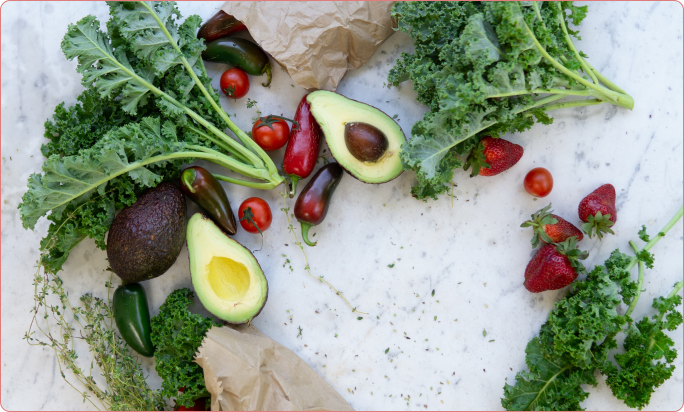Making a transition to a healthier diet can be difficult. We are heavily influenced by outside sources as to what we choose to eat – social, environmental, mental, physical, cultural, and economic.
Each have an impact on what we decide to buy and consume both at home and away from home. We’ll focus on managing your environmental factors with this article.
Environmental cues can trigger food choice habits and can support a healthy diet if we have the right foods and tools easily accessible and available. To set ourselves up for success, it is good to weed out less healthy options in favour of healthier alternatives.
Here are 15 things that you can do to improve your environmental factors at home and work for a healthier diet and better weight management:
- Try to avoid buying juice for the household. Our body digests juice similar to how we digest granulated sugar and can increase the risk of high blood sugars which trigger hunger pangs. Instead, choose whole fruit. Fruit contains fibre which slows down how fast sugar enters our bloodstream, decreasing the risk of high blood sugars and keeps our hunger in check.
- Reduce the number of desserts, pastries, ice cream, and deep-fried foods in your household. Cutting out foods from our diet entirely can lead to stronger cravings and can also decrease control around craved foods when they’re in front of you. Instead, avoid keeping these foods in your household. You are more likely to eat something more often if it is easy to access. Chips at 3 am? Guilty!
- Opt for the “no-sugar-added” versions of commonly eaten foods. Sugar sweetened foods are less beneficial for weight management and increases the risk of high blood sugars. They also add (often unnecessary) sneaky calories, that counted throughout the day, can really add up. Healthy switches may include natural peanut butter instead of regular, plain yogurt or zero sugar yogurt instead of flavoured, and fresh or frozen fruit instead of canned/cup fruit packed in syrup.
- Replace dried fruit with fresh or frozen fruit in your household. Dried fruit contains less water than fresh and frozen fruit. This makes it less filling than fresh or frozen fruit and can be easily eaten in large quantities. Fresh fruit or frozen fruit is harder to overeat and leaves us feeling more satisfied.
- Opt for wholegrain alternatives to commonly eaten foods. Whole grains decrease the risk of high blood sugars. Try wholegrain breads and pasta, and brown rice instead of their white processed counterparts.
- Try to keep sugar sweetened beverages out of your household. It is better to opt for sugar-free beverage. Try having water, plain tea, plain milk, or carbonated water rather than pop and chocolate milk.
- Consider plating your food rather than eating buffet style. Plating our food at meals can help us visualize if we are getting enough vegetables, fruit, and protein. If we pick away at foods individually it can be hard to know exactly how much we might have eaten of each food. It’s easy to over eat when grabbing snacks out of a bag, instead of putting into a bowl. It is good to think of your plate as a pie chart. Aim for half a plate of vegetables/fruit, a quarter plate of high-fibre grain or starches, and a quarter plate of lean protein.
- Swap fattier meats for plant-based proteins, seafood, and/or lean cuts of meats. There are many benefits to plant-based proteins, fish, and lean cuts of meats. They all provide essential nutrients without providing excessive amounts of saturated fat. Beans, legumes, nuts, and seeds have the additional benefit of fibre. Fatty fish, nuts, and seeds can also be a source of healthy fats such as omega 3 and monounsaturated fats. Lean meats and seafood provide more protein per calorie. This reduces excess calorie intake and decreases saturated fat.
- Opt have higher protein options of commonly eaten foods and drinks within the household. There are many household staples that come in higher protein options. Milk, breads, and pasta are often the most common foods. There are brands of milk that have 50-75% more protein such as Joyya, Fairelife, Ultrapur and Natrel Plus. There are also many sprouted grain alternatives for bread and even chickpea or lentil pastas that offer more protein. Using these foods as replacements can help you manage hunger levels. They can also decrease losses in muscle mass that are common during weight loss.
- Limit your outside distractions during meals. Try to have meals without screens or reading materials in front of you – distractions can make us more likely to overeat. Putting away distractions helps us notice our own internal hunger and satiety cues.
- Have precut and ready to snack vegetable options. If it’s in your budget, consider buying fresh vegetables prewashed or save money by washing and cutting them in bulk. Then you can place them into vegetable saver containers in your fridge. Consider using frozen or canned vegetables in meals and for snacks. They are commonly already prepared for use.
- Find high protein snack options. Protein helps decrease hunger levels and helps maintain muscle. Some quick and easy protein snack options could include some Greek yogurt or cottage cheese, edamame, lupini beans, or low-fat cheese.
- Place the foods that you want to eat more often in easy to find places. Place healthier foods at the front of your fridge, freezer, or cupboard. Visual cues impact our food choices. They can remind us of the healthy options. Healthy foods can sometimes be forgotten (sad, slimy veggies in the bottom drawer anyone?). This may even contribute to food waste if they are not in plain sight.
- Try to keep less healthy options in harder-to-find, harder-to-reach areas. When you have treats in the home like chips, cookies, cakes, and ice cream, keep them in drawers, at the back of cupboards, or in areas of the fridge and freezer that we do not frequently access. This can minimize the effects visual cues that may have on our food choices.
- Consider setting visual or auditory cues to remind you to eat meals and snacks. We live in a fast-paced society with many obligations. It’s uncommon to accidentally miss a meal or two. It can help to set audio or visual reminders on your phone or computer using the calendar or alarm app to remind yourself of mealtimes. Eating frequent healthy snacks and regular meals reduces excessive hunger which also reduces the risk of overeating at mealtimes.
It is said that diets and weight loss starts in the kitchen, which is very true. Making healthy choices at the grocery store means you can better manage the environmental effects on your diet. Bon appetit!
References:
Tabares-Tabares, M., Moreno Aznar, L. A., Aguilera-Cervantes, V. G., León-Landa, E., & López-Espinoza, A. (2022). Screen use during food consumption: Does it cause increased food intake? A systematic review. Appetite, 171, 105928. https://doi.org/10.1016/J.APPET.2022.105928





